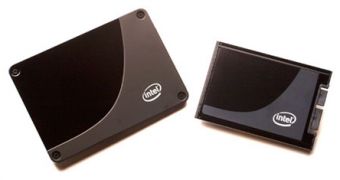Ever since Intel launched its highly anticipated X18-M and X25-M Solid State Drives in early September, the company has constantly claimed that its new flash-based storage product were specifically designed to boost the performance of current solid state drives, which are known for not delivering the expected performance. However, until now, we haven't really seen what these drives are actually capable of, at least not from a more professional and objective point of view.
Sometime last week, the guys over at HotHardware posted an article regarding the performance level achieved by a RAID 0 configuration, set up of two Intel X25-M SSDs. The article is actually made of a series of tests and benchmarks that are meant to record the performance level achieved by Intel's latest SSDs. The Test platform included an ASUS Striker II Extreme (790i SLI Ultra chipset) motherboard, Intel's Core 2 Extreme QX6850 processor, 2GB of Corsair DDR3 1333MHz memory and a GeForce 8800GTX graphics card. There was no separate RAID controller card, as the guys used the on-board NVIDIA RAID controller.
After running a series of tests, the two Intel X25-M SSDs, connected in RAID 0, rendered quite impressive performance numbers. Starting with Sandra's HDD Read benchmark, where the 160GB RAID 0 configuration achieved a maximum speed of 396.14MB/s, and ending with the Read benchmark from the HD Tach utility, where the two Intel SSDs achieved a speed of 331.9MB/s, it was clear that this storage solution was really fast. In addition, the RAID 0 configuration rendered an impressive 5834.53 IOps.
Now, as most of you already know, SSDs do provide an improved performance level over standard HDDs, but at a significantly higher price tag. If you already have a high-performance desktop computer rig, you will only need to invest about an additional $600 so you can also benefit from the advantages delivered by a RAID 0 configuration of two Intel X25-M SSDs.

 14 DAY TRIAL //
14 DAY TRIAL //